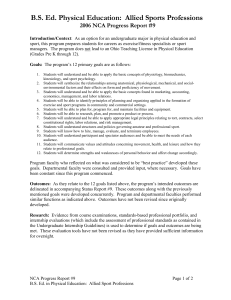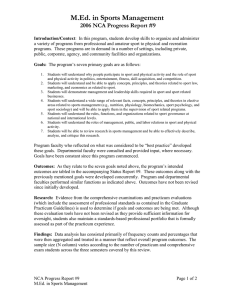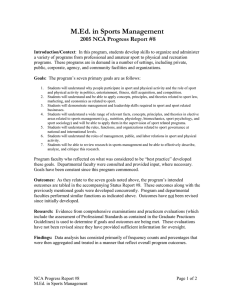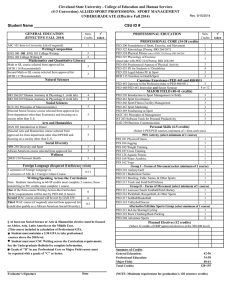B.S. Ed. Physical Education: Allied Sports Professions
advertisement
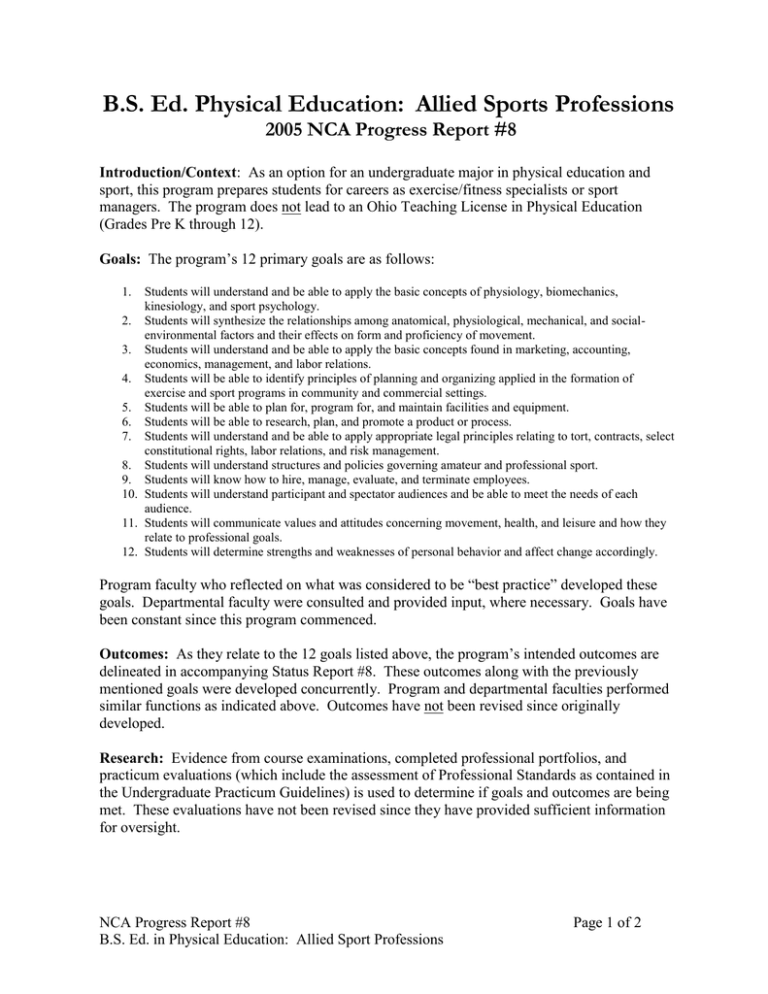
B.S. Ed. Physical Education: Allied Sports Professions 2005 NCA Progress Report #8 Introduction/Context: As an option for an undergraduate major in physical education and sport, this program prepares students for careers as exercise/fitness specialists or sport managers. The program does not lead to an Ohio Teaching License in Physical Education (Grades Pre K through 12). Goals: The program’s 12 primary goals are as follows: 1. Students will understand and be able to apply the basic concepts of physiology, biomechanics, kinesiology, and sport psychology. 2. Students will synthesize the relationships among anatomical, physiological, mechanical, and socialenvironmental factors and their effects on form and proficiency of movement. 3. Students will understand and be able to apply the basic concepts found in marketing, accounting, economics, management, and labor relations. 4. Students will be able to identify principles of planning and organizing applied in the formation of exercise and sport programs in community and commercial settings. 5. Students will be able to plan for, program for, and maintain facilities and equipment. 6. Students will be able to research, plan, and promote a product or process. 7. Students will understand and be able to apply appropriate legal principles relating to tort, contracts, select constitutional rights, labor relations, and risk management. 8. Students will understand structures and policies governing amateur and professional sport. 9. Students will know how to hire, manage, evaluate, and terminate employees. 10. Students will understand participant and spectator audiences and be able to meet the needs of each audience. 11. Students will communicate values and attitudes concerning movement, health, and leisure and how they relate to professional goals. 12. Students will determine strengths and weaknesses of personal behavior and affect change accordingly. Program faculty who reflected on what was considered to be “best practice” developed these goals. Departmental faculty were consulted and provided input, where necessary. Goals have been constant since this program commenced. Outcomes: As they relate to the 12 goals listed above, the program’s intended outcomes are delineated in accompanying Status Report #8. These outcomes along with the previously mentioned goals were developed concurrently. Program and departmental faculties performed similar functions as indicated above. Outcomes have not been revised since originally developed. Research: Evidence from course examinations, completed professional portfolios, and practicum evaluations (which include the assessment of Professional Standards as contained in the Undergraduate Practicum Guidelines) is used to determine if goals and outcomes are being met. These evaluations have not been revised since they have provided sufficient information for oversight. NCA Progress Report #8 B.S. Ed. in Physical Education: Allied Sport Professions Page 1 of 2 Findings: Data analysis has consisted primarily of frequency counts and percentages that were then aggregated and treated in a manner that reflect overall program outcomes. Review: Program faculty is polled once or twice a year depending on the circumstances. Actions: Overall, data-based decision-making has reinforced the department’s primary focus and initial direction as it relates to student learning. Program and departmental faculties have felt the need to take remedial actions only in isolated circumstances, e.g., revising examination and aligning it with criterion material taught in PED 461 and addressing more comprehensively the topic of personnel management in PED 480/481. NCA Progress Report #8 B.S. Ed. in Physical Education: Allied Sport Professions Page 2 of 2
